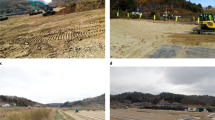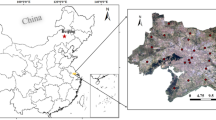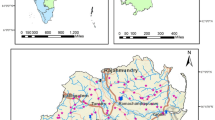Abstract
Background
Hurricane Florence made landfall in North Carolina in September 2018 causing extensive flooding. Several potential point sources of hazardous substances and Superfund sites sustained water damage and contaminants may have been released into the environment.
Objective
This study conducted temporal analysis of contaminant distribution and potential human health risks from Hurricane Florence-associated flooding.
Methods
Soil samples were collected from 12 sites across four counties in North Carolina in September 2018, January and May 2019. Chemical analyses were performed for organics by gas chromatography-mass spectrometry. Metals were analyzed using inductively coupled plasma mass spectrometry. Hazard index and cancer risk were calculated using EPA Regional Screening Level Soil Screening Levels for residential soils.
Results
PAH and metals detected downstream from the coal ash storage pond that leaked were detected and were indicative of a pyrogenic source of contamination. PAH at these sites were of human health concern because cancer risk values exceeded 1 × 10−6 threshold. Other contaminants measured across sampling sites, or corresponding hazard index and cancer risk, did not exhibit spatial or temporal differences or were of concern.
Significance
This work shows the importance of rapid exposure assessment following natural disasters. It also establishes baseline levels of contaminants for future comparisons.
This is a preview of subscription content, access via your institution
Access options
Subscribe to this journal
Receive 6 print issues and online access
$259.00 per year
only $43.17 per issue
Buy this article
- Purchase on Springer Link
- Instant access to full article PDF
Prices may be subject to local taxes which are calculated during checkout






Similar content being viewed by others
References
Plumlee GS, Morman GP, Meeker TM, Hoefen PL, Hageman RE, Wolf RE. 11.7—the environmental and medical geochemistry of potentially hazardous materials produced by disasters. Treatise Geochem. 2014;11:257–304.
Rieble DD, Hass CN, Pardue J, Walsh W. Toxic and contaminant concerns generated by hurricane Katrina. J Environ Engin. 2006;36:5–13.
Diaz JH. The public health impact of hurricanes and major flooding. J La State Med Soc. 2004;156:145–50.
Ahern M, Kovats RS, Wilkinson P, Few R, Matthies F. Global health impacts of floods: epidemiologic evidence. Epidemiol Rev. 2005;27:36–46.
Joyce S. The dead zones: oxygen-starved coastal waters. Environ Health Perspect. 2000;108:A120–5.
Euripidou E, Murray V. Public health impacts of floods and chemical contamination. J Public Health (Oxf). 2004;26:376–83.
Cruz AM, Steinberg LJ, Luna R. Identifying hurricane-induced hazardous material release scenarios in a petroleum refinery. Nat Hazards Rev. 2001;2:203–10.
Krausmann E, Mushtaq F. A qualitative Natech damage scale for the impact of floods on selected industrial facilities. Nat Hazards. 2008;46:179–97.
Mandigo AC, DiScenza DJ, Keimowitz AR, Fitzgerald N. Chemical contamination of soils in the New York City area following Hurricane Sandy. Environ Geochem Health. 2016;38:1115–24.
Woodruff JD, Irish JL, Camargo SJ. Coastal flooding by tropical cyclones and sea-level rise. Nature. 2013;504:44–52.
Peduzzi P, Chatenoux B, Dao H, De Bono A, Herold C, Kossin J, et al. Global trends in tropical cyclone risk. Nat Clim Change. 2012;2:289.
Knutson TR, McBride JL, Chan J, Emanuel K, Holland G, Landsea C, et al. Tropical cyclones and climate change. Nat Geosci. 2010;3:157.
Knap AH, Rusyn I. Environmental exposures due to natural disasters. Rev Environ Health. 2016;31:89–92.
Winsor M. Timeline of Florence as slow-moving, deadly storm batters Carolinas. ABC News. 2018.
Coyte RM, McKinley KL, Jiang S, Karr J, Dwyer GS, Keyworth AJ, et al. Occurrence and distribution of hexavalent chromium in groundwater from North Carolina, USA. Sci Total Environ. 2020;711:135135.
Ruhl L, Vengosh A, Dwyer GS, Hsu-Kim H, Deonarine A. Environmental impacts of the coal ash spill in Kingston, Tennessee: an 18-month survey. Environ Sci Technol. 2010;44:9272–8.
U.S. EPA. Coal ash basics. Washington, DC: U.S. Environmental Protection Agency; 2020. https://www.epa.gov/coalash/coal-ash-basics.
Dewitt D. Researcher: Sutton Lake site of numerous coal ash spills. North Carolina Public Radio. 2019.
Ouzts E. Critics: North Carolina officials ‘failing’ after Florence coal ash spills. Energy News Network. 2018. https://energynews.us/2018/10/16/southeast/critics-north-carolina-officials-failing-after-florence-coal-ash-spills/.
Biesecker M, Kastanis A. Hurricane Florence breaches manure lagoon, coal ash pit in North Carolina. 2018. https://www.pbs.org/newshour/nation/hurricane-florence-breaches-manure-lagoon-coal-ash-pit-in-north-carolina.
National Hurricane Center. Tropical cyclone report: Hurricane Florence. Contract No.: AL062018, Miami, FL; 2019.
U.S. EPA. Soil sampling operating procedure. U.S. Environmental Protection Agency, editor. Athens, GA: U.S. EPA; 2007.
Cantillo AY, Lauenstein, GG. Performance-based quality assurance—The NOAA National Status and Trends Program Experience. National Oceanic and Atmospheric Administration (NOAA), editor. NOAA. Silver Spring, MD; 1998.
U.S. EPA. National Coastal Condition Assessment Quality Assurance Project Plan. United States Environmental Protection Agency, editor. Washington, DC: U.S. EPA; 2010.
Silva MH, Kwok A. Open access ToxCast/Tox21, toxicological priority index (ToxPi) and integrated chemical environment (ICE) models rank and predict acute pesticide toxicity: a case study. Int J Toxicol Envr Health. 2020;5:102–25.
Bera G, Camargo K, Sericano JL, Liu Y, Sweet ST, Horney J, et al. Baseline data for distribution of contaminants by natural disasters: results from a residential Houston neighborhood during Hurricane Harvey flooding. Heliyon. 2019;5:e02860.
El-Kady AA, Wade TL, Sweet ST, Sericano JL. Distribution and residue profile of organochlorine pesticides and polychlorinated biphenyls in sediment and fish of Lake Manzala, Egypt. Environ Sci Pollut Res Int. 2017;24:10301–12.
Cook RD. Detection of influential observations in linear regression. Technometrics. 1977;19:15–8.
Wang Z, Yang C, Parrott JL, Frank RA, Yang Z, Brown CE, et al. Forensic source differentiation of petrogenic, pyrogenic, and biogenic hydrocarbons in Canadian oil sands environmental samples. J Hazard Mater. 2014;271:166–77.
Lu J, Zhang C, Wu J, Lin YC, Zhang YX, Yu XB, et al. Pollution, sources, and ecological-health risks of polycyclic aromatic hydrocarbons in coastal waters along coastline of China. Hum Ecol Risk Assess. 2020;26:968–85.
U.S. EPA. Regional Screening Levels RSLS Generic Tables. Washington, DC: U.S. Environmental Protection Agency; 2020. https://www.epa.gov/risk/regional-screening-levels-rsls-generic-tables.
Nisbet IC, LaGoy PK. Toxic equivalency factors (TEFs) for polycyclic aromatic hydrocarbons (PAHs). Regulatory Toxicol Pharmacol. 1992;16:290–300.
U.S. EPA. Development of a relative potency factor (Rpf) approach for polycyclic aromatic hydrocarbon (PAH) mixtures (external review draft). Washington, DC: U.S. Environmental Protection Agency; 2010.
U.S. EPA. Provisional guidance for quantitative risk assessment of polycyclic aromatic hydrocarbons (PAH). Washington, DC: U.S. Environmental Protection Agency, Office of Research and Development, Office of Health and Environmental Assessment; 1993.
Vengosh A, Cowan EA, Coyte RM, Kondash AJ, Wang Z, Brandt JE, et al. Evidence for unmonitored coal ash spills in Sutton Lake, North Carolina: Implications for contamination of lake ecosystems. Sci Total Environ. 2019;686:1090–103.
IARC. Some non-heterocyclic polycyclic aromatic hydrocarbons and some related exposures. Cancer IAfRo, editor. Lyon, France: WHO; 2010.
Myers J, Thorbjornsen K. Identifying metals contamination in soil: a geochemical approach. Soil Sediment Contam. 2004;13:1–16.
Wang ZD, Fingas M, Shu YY, Sigouin L, Landriault M, Lambert P, et al. Quantitative characterization of PAHs in burn residue and soot samples and differentiation of pyrogenic PAHs from petrogenic PAHs—The 1994 Mobile Burn Study. Environ Sci Technol. 1999;33:3100–9.
USGS. Geochemical and mineralogical data for soils of the conterminous United States. U.S. Department of the Interior, editor. Reston, VA: U.S. Geological Survey; 2013.
National Weather Service. Historical Hurricane Florence, September 12–15, 2018. 2018. https://www.weather.gov/mhx/Florence2018.
Errett NA, Haynes EN, Wyland N, Everhart A, Pendergrast C, Parker EA. Assessing the national capacity for disaster research response (DR2) within the NIEHS Environmental Health Sciences Core Centers. Environ Health. 2019;18:61.
Horney JA, Rios J, Cantu A, Ramsey S, Montemayor L, Raun L, et al. Improving Hurricane harvey disaster research response through academic-practice partnerships. Am J Public Health. 2019;109:1198–201.
Amolegbe S. Texas workshop prepares trainees for disaster research. NIEHS Environmental Factor. 2019. https://factor.niehs.nih.gov/2019/3/science-highlights/disaster_research/index.htm.
Schwartz GE, Hower JC, Phillips AL, Rivera N, Vengosh A, Hsu-Kim H. Ranking coal ash materials for their potential to leach arsenic and selenium: relative importance of ash chemistry and site biogeochemistry. Environ Eng Sci. 2018;35:728–38.
Srivastava VK, Srivastava PK, Misra UK. Polycyclic aromatic hydrocarbons of coal fly ash: analysis by gas-liquid chromatography using nematic liquid crystals. J Toxicol Environ Health. 1985;15:333–7.
Kravchenko J, Lyerly HK. The impact of coal-powered electrical plants and coal ash impoundments on the health of residential communities. N C Med J. 2018;79:289–300.
Horney JA, Casillas GA, Baker E, Stone KW, Kirsch KR, Camargo K, et al. Comparing residential contamination in a Houston environmental justice neighborhood before and after Hurricane Harvey. PLoS ONE. 2018;13:e0192660.
Harkness JS, Sulkin B, Vengosh A. Evidence for coal ash ponds leaking in the Southeastern United States. Environ Sci Technol. 2016;50:6583–92.
Weston J, Warren C, Chaudhary A, Emerson B, Argote K, Khan S, et al. Use of bioassays and sediment polycyclic aromatic hydrocarbon concentrations to assess toxicity at coastal sites impacted by Hurricane Katrina. Environ Toxicol Chem. 2010;29:1409–18.
Warren C, Duzgoren-Aydin NS, Weston J, Willett KL. Trace element concentrations in surface estuarine and marine sediments along the Mississippi Gulf Coast following Hurricane Katrina. Environ Monit Assess. 2012;184:1107–19.
Acknowledgements
The authors wish to thank Dr. Elena Craft (Environmental Defense Fund) for assistance with sampling logistics. This work was funded, in part, by grants P42 ES027704, P30 ES029067, and T32 ES026568 from the National Institute of Environmental Health Sciences. The use of specific commercial products in this work does not constitute endorsement by the funding agency.
Author information
Authors and Affiliations
Corresponding author
Ethics declarations
Conflict of interest
The authors declare no competing interests.
Additional information
Publisher’s note Springer Nature remains neutral with regard to jurisdictional claims in published maps and institutional affiliations.
Supplementary Information
Rights and permissions
About this article
Cite this article
Aly, N.A., Casillas, G., Luo, YS. et al. Environmental impacts of Hurricane Florence flooding in eastern North Carolina: temporal analysis of contaminant distribution and potential human health risks. J Expo Sci Environ Epidemiol 31, 810–822 (2021). https://doi.org/10.1038/s41370-021-00325-5
Received:
Revised:
Accepted:
Published:
Issue Date:
DOI: https://doi.org/10.1038/s41370-021-00325-5
Keywords
This article is cited by
-
ToxPi*GIS Toolkit: creating, viewing, and sharing integrative visualizations for geospatial data using ArcGIS
Journal of Exposure Science & Environmental Epidemiology (2022)
-
Utilizing ion mobility spectrometry-mass spectrometry for the characterization and detection of persistent organic pollutants and their metabolites
Analytical and Bioanalytical Chemistry (2022)
-
Comparative assessment of blood mercury in American alligators (Alligator mississippiensis) from Coastal North Carolina and Florida
Ecotoxicology (2022)
-
Exposure science perspective on disaster preparedness and resilience
Journal of Exposure Science & Environmental Epidemiology (2021)



